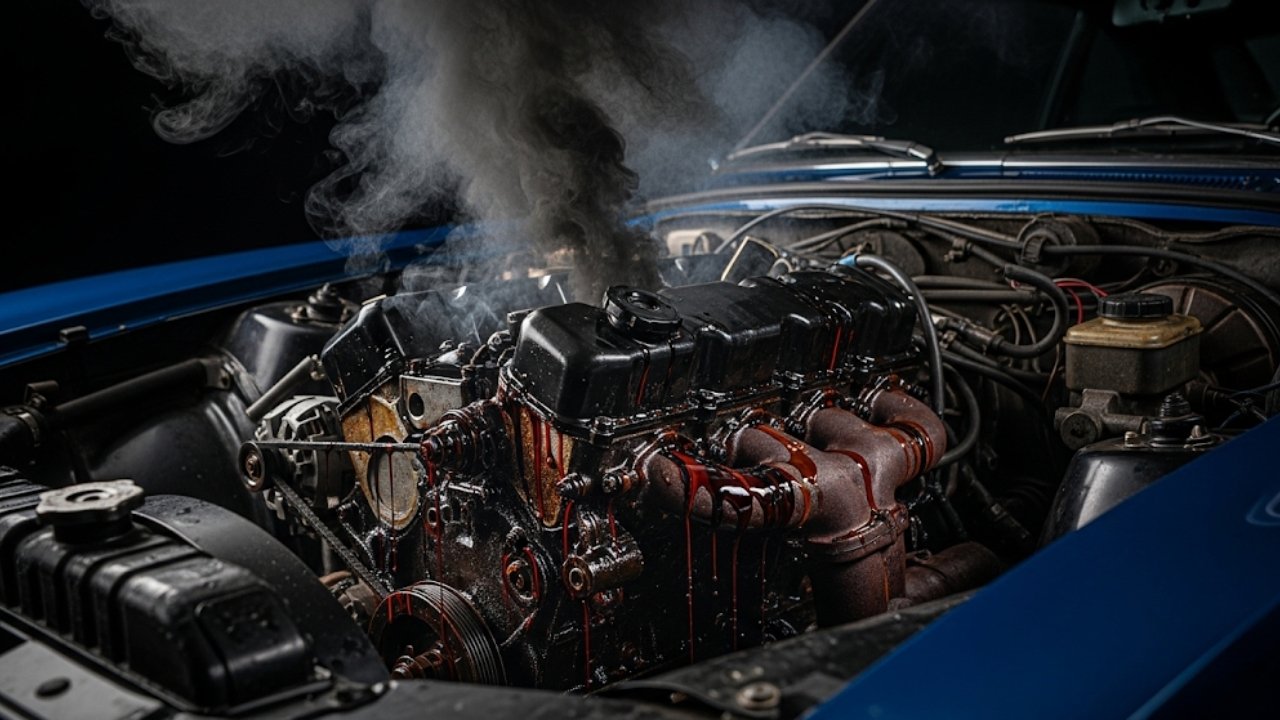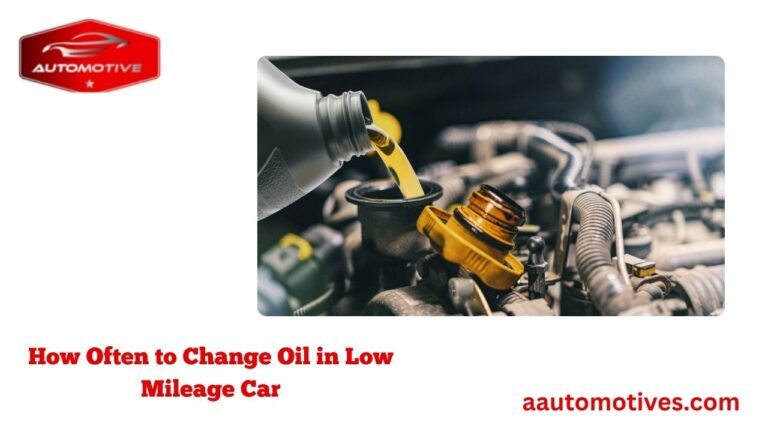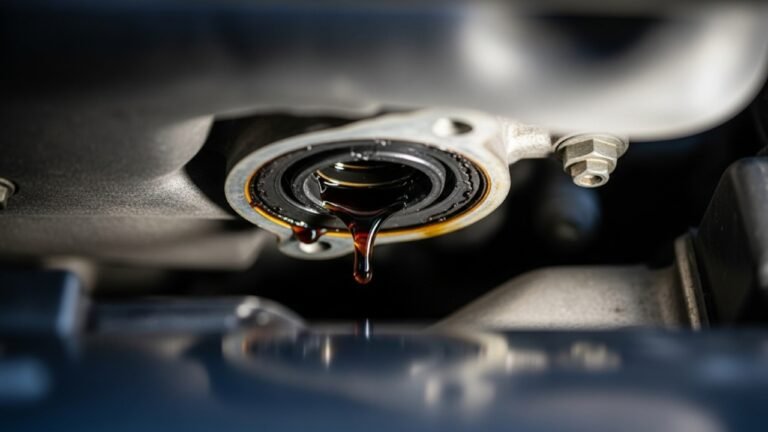What Happens When a Car Has Too Much Oil?

We’ve all heard the phrase, “More is better,” right? It’s something our parents said when we were piling up rice at dinner or when adding more sugar to tea. But when it comes to your car’s engine oil, that saying couldn’t be more wrong. Trust me, I’ve learned this the hard way.
You might think putting a bit more oil in your car is harmless—or even helpful. After all, oil keeps the engine running smoothly, so more must mean better protection, right? Sadly, no.
What happens when a car has too much oil isn’t always immediate, but it can creep up and cause problems that will leave your wallet thinner and your engine coughing up its last breath. This article breaks it all down in a simple, human way—no complicated jargon. We’ll look at what goes wrong, how to spot the signs, and how to fix or avoid it altogether.
Let’s take this journey together.
Why Oil Matters: The Lifeline of Your Engine

-
Lubricates moving parts
-
Cools down hot components
-
Cleans away dirt and debris
Without it, your engine would seize up, overheat, or grind itself to death. But there’s a catch—too much oil in your car can turn this lifesaver into a silent killer.
Imagine wearing boots two sizes too big. Sure, you can walk, but after a while, you’ll trip, stumble, and possibly sprain an ankle. That’s what overfilled oil does to your car’s insides—it throws everything off balance.
How Overfilling Happens: A Common Mistake
You don’t have to be a newbie to make this mistake. Even seasoned car owners do it. Overfilling usually happens when:
-
You top off oil without checking the dipstick properly
-
You use the wrong oil capacity for your engine
-
You go for an oil change at a shady garage where the tech isn’t paying attention
-
You think, “Let me just add a little extra, just in case.”
I once did this before a long trip, thinking I was giving my car a boost. A week later, I noticed white smoke from the exhaust. And that was just the start…
What Happens When a Car Has Too Much Oil? (The Real Damage)
Let’s get to the heart of it. When your engine has too much oil, it can’t flow the way it’s supposed to. Here’s a breakdown of the problems it can cause:
| Problem | Description |
|---|---|
| Foaming | Extra oil gets whipped by the crankshaft, turning into foam instead of liquid. Foamy oil can’t lubricate. |
| Increased Pressure | Oil pressure rises unnaturally, straining seals and gaskets. |
| Blown Seals | Excess pressure can blow out seals, causing leaks. |
| Catalytic Converter Damage | Oil gets into the exhaust system and damages the converter. |
| Spark Plug Fouling | Oil makes its way into combustion chambers and clogs spark plugs. |
| Engine Misfire | A result of spark plug issues and improper combustion. |
| Bent Rods or Crankshaft | In severe cases, “hydro-lock” can occur when oil fills cylinders. |
This isn’t just theory. Mechanics see this every day. And many of them say they’d rather fix a slightly dry engine than one overstuffed with oil.
The Warning Signs: How to Know If You’ve Overfilled
Don’t panic just yet. If you’re worried you might’ve added too much oil, here are some symptoms you can watch for:
-
White or blue smoke coming from the exhaust
-
Strong oil smell inside or around your car
-
Leaking oil on your driveway or under the hood
-
Rough idling or engine running differently
-
Oil dipstick shows over the “MAX” line
-
Check Engine Light may come on
-
Unusual engine sounds, like knocking or ticking
These signs don’t always scream “disaster,” but they’re your car’s way of whispering, “Hey buddy, something’s off.”
I remember once seeing a puff of smoke and thinking, “Eh, probably just cold weather.” Spoiler: it wasn’t. It was oil burning where it shouldn’t be.
Short-Term Effects: Don’t Wait Too Long
Even if you catch the problem early, too much oil in your car can cause problems fast. Think of it like overeating before a marathon. You might still run, but you’ll feel sick halfway in.
Short-term issues can include:
-
Sluggish performance (your car feels heavier or slow)
-
Oil leaks from stressed gaskets
-
Rough starts in cold weather
-
Lower fuel economy
-
Smoky exhaust embarrassing you at traffic lights
None of these will destroy your car immediately, but let them go on, and you’re paving the way to costly repairs.
Long-Term Consequences: When You Don’t Take Action
Let’s say you don’t notice—or ignore—the signs. What happens next?
Over months or even weeks:
-
Your spark plugs degrade, reducing engine efficiency.
-
Your catalytic converter clogs up, which might lead to failing emissions tests (and expensive replacement).
-
The engine seals start to give way, dripping oil in places it should never be.
-
And in worst-case scenarios, engine failure hits. Yep, the big one.
Imagine getting stuck on a highway, hood up, steam everywhere, waiting for a tow truck. Just because of too much oil? Sadly, yes.
Can You Fix It Yourself? (Here’s What to Do)
Here’s the good news—this problem can be fixed without a mechanic if you act quickly. If you realize your mistake early, try this:
Step-by-Step Fix:
-
Check the dipstick: Wait for the engine to cool, pull it out, and look.
-
If it’s overfilled, use one of the methods below:
-
Drain plug method: Remove the drain plug under the engine for a few seconds, then reseal it.
-
Oil extractor pump: This is a cleaner, easier method. Use it to pull excess oil from the dipstick tube.
-
-
Check again: Always recheck the oil level after any adjustment.
-
Start the engine and observe: No smoke? No weird sounds? You’re good.
Don’t forget to dispose of the used oil responsibly—most auto shops will take it for free.
Preventing the Problem: Be a Smart Car Owner
Mistakes happen. But once you know better, you can do better.
Here are some quick tips:
-
Always check your dipstick before and after adding oil.
-
Know your car’s oil capacity—look it up in your owner’s manual or online.
-
Avoid topping off unless you’re sure the level is low.
-
If using a mechanic, double-check their work or ask questions.
You wouldn’t feed a baby an adult’s portion. Don’t feed your car more oil than it can handle.
How Mechanics See It: A Professional Perspective
I had a conversation once with a mechanic friend, Saleh bhai, from my local garage in Dhaka. He’s worked on everything from beat-up buses to shiny BMWs. He said something that stuck with me:
“Engines are like lungs. Too much oil is like drowning them. You wouldn’t breathe properly if water went down your lungs, would you?”
That hit hard.
Most mechanics agree that overfilling oil is one of the most preventable engine problems they see. And guess what? Many of the victims are well-meaning drivers who just wanted to “take care of their car.”
From their point of view, symptoms like:
-
Excessive tailpipe smoke
-
Frequent stalling
-
Poor acceleration
…are tell-tale signs that too much oil in a car is making the engine struggle like a swimmer gasping for air.
How It Affects Different Car Types: Not All Engines React the Same
Interestingly, different types of cars respond differently to oil overfill:
| Vehicle Type | Oil Overfill Reaction |
|---|---|
| Small cars (1.0-1.5L engines) | Sensitive—quickly show symptoms like smoke and knocking. |
| SUVs & pickups | More tolerance, but internal wear accelerates silently. |
| Turbocharged engines | High risk—can damage turbo seals and cause oil leaks into intake. |
| Hybrids | Engine misfires and emissions issues appear faster. |
| Performance sports cars | Sensitive to oil levels; can affect oil pressure and cause power loss. |
So, whether you’re driving a Toyota Axio or a Nissan Patrol, the damage scale might differ, but the risk is always real.
Emotional Toll: It’s More Than Just Money
We often talk about the cost of repairs. But let’s not ignore the emotional weight.
Imagine this:
You’re saving up for Eid. You have plans—family, food, maybe even a quick road trip. Suddenly, your car breaks down, and the mechanic says the engine’s shot. You’re confused. You were only trying to protect it.
That feeling of guilt? Frustration? Been there.
Too much oil in your car may seem harmless, but when the damage sinks in, it’s not just about money—it’s about stress, delays, and disappointment. That’s why it matters to stay informed.
FAQs: Real Questions from Real Drivers
1. Can too much oil damage your engine permanently?
Yes. If left unchecked, it can cause irreversible damage like a blown head gasket, ruined catalytic converter, or full engine failure.
2. How do I check if I added too much oil?
Use the dipstick. If the oil line is above the “MAX” mark, you’ve added too much.
3. Will driving a short distance with too much oil hurt the engine?
It depends. A very slight overfill may be safe for short drives. But significant overfilling—even once—can cause long-term harm.
4. Is it better to have a little too much or a little too little oil?
Neither is good, but a slightly low level is often safer than overfilling. Low oil can be topped up. Overflow can flood systems.
5. Can I just wait for the oil to burn off naturally?
No! That’s risky. You might end up causing engine misfires or fouling spark plugs before the level adjusts.
6. How much overfill is dangerous?
Even half a quart (approx. 500ml) over the limit can be problematic in small engines. Always follow your car’s manual.
7. Can a mechanic fix this easily?
Absolutely. Most mechanics can drain or extract oil in minutes. But act fast—the sooner, the better.
8. How long before symptoms appear?
Sometimes within minutes, sometimes after a few days. It depends on your driving habits, engine size, and how much oil is overfilled.
A Cultural Reflection: Why We Tend to Overdo It
Let’s be honest—many of us come from cultures where “extra” equals “better.” Whether it’s serving double helpings of rice or giving more wedding gifts, we associate abundance with care.
And when it comes to cars, we follow the same logic.
But just like overfeeding can lead to indigestion, overfilling engine oil leads to breakdowns. It’s time we shift the mindset.
Caring for your car isn’t about doing more—it’s about doing what’s right.
Expert Tips: What the Pros Do Differently
Want to maintain your car like a pro? Here are a few expert secrets:
-
Buy a good oil funnel: This helps prevent accidental spills and overfills.
-
Measure out your oil in a jug before pouring it in.
-
Replace the oil filter during each oil change—it affects capacity and performance.
-
Use an OBD scanner: These gadgets can catch early warnings that your dashboard might miss.
-
Keep a maintenance journal: Write down when you added oil, how much, and what brand.
Visual Guide: The Good vs. The Bad
Here’s a quick visual to help compare the outcomes:
| Scenario | Outcome |
|---|---|
| Right oil level | Smooth performance, long engine life, fuel efficiency. |
| Slightly low oil | Slight wear over time, but manageable with top-off. |
| Too much oil | Risk of foaming, pressure build-up, leaks, and damage. |
Conclusion: Know Better, Drive Smarter
So here’s the bottom line—what happens when a car has too much oil isn’t a mystery anymore. It’s a silent engine killer. It doesn’t scream for help right away. It whispers. And if you ignore those whispers, the shouts (and the repair bills) will follow.
But now, you know what to look for. You know how to fix it. More importantly, you know how to avoid it.
Cars, like relationships, thrive on balance. Not too much. Not too little. Just the right amount of attention and care. Whether you’re cruising through city streets or heading for the countryside, make sure your engine breathes easy.
Because when you take care of your car, it takes care of you.






